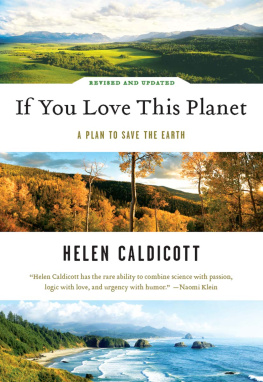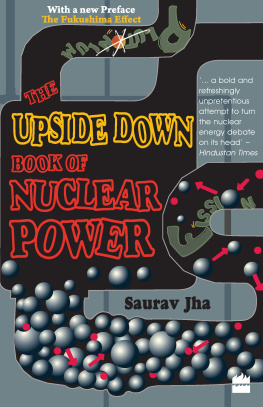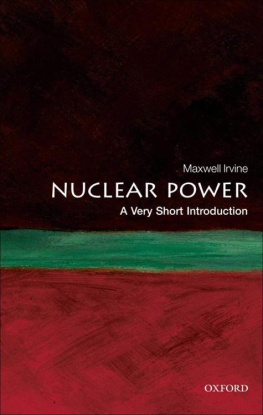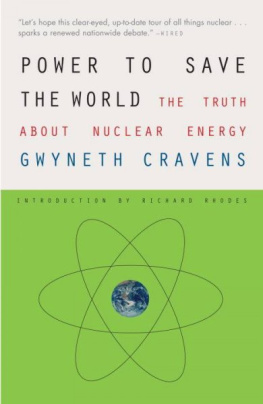Pagebreaks of the print version

Also by Helen Caldicott
from The New Press
The New Nuclear Danger:
George W. Bushs Military-Industrial Complex
Nuclear Power
Is Not the Answer
Helen Caldicott

2006 by Helen Caldicott All rights reserved.
All rights reserved.
No part of this book may be reproduced, in any form, without written permission from the publisher.
Requests for permission to reproduce selections from this book should be mailed to:
Permissions Department, The New Press, 38 Greene Street, New York, NY 10013.
Published in the United States by The New Press, New York, 2006
Distributed by W. W. Norton & Company, Inc., New York
LIBRARY OF CONGRESS CATALOGING-IN-PUBLICATION DATA
Caldicott, Helen.
Nuclear power is not the answer / Helen Caldicott.
p. cm.
Includes bibliographical references and index.
ISBN13 9781595580672 (hc)
ISBN10 1595580670 (hc)
1. Nuclear industryUnited States. 2. Nuclear energyUnited States.
3. Global warmingPrevention. 4. Nuclear power plantsUnited States. 5. Energy policyUnited States. I. Title.
HD9698.U52C33 2006
333.79240973dc22 2006041990
The New Press was established in 1990 as a not-for-profit alternative to the large, commercial publishing houses currently dominating the book publishing industry. The New Press operates in the public interest rather than for private gain and is committed to publishing, in innovative ways, works of educational, cultural, and community value that are often deemed insufficiently profitable.
www.thenewpress.com
Composition by Westchester Book Group
For my beloved grandchildren
Mikhael, Rachel, Paul, Claire, Oscar and Tess.
Acknowledgments
I have much gratitude for the invaluable help, knowledge, advice, and support provided by the many people who assisted in compiling this book. They include Mary Cunnane, Jan Willem Storm van Leeuwen, Philip Smith, Tom Cochran, Dan Hirsch, Arjun Makhijani, Brice Smith, Paul Craig, David Lochbaum, Gordon Thompson, Bob Alveraz, Paul Gunter, Anna Aurilio, Kay Drey, Ed Lyman, David Richardson, Steve Wing, Amory Lovins, Harvey Wasserman, Tom Fasy, Kevin Kamps, Charles Sheehan-Miles, Bruce Biewald, Mary Osborn, Scott Powell, Ernest Sternglass, and Peter Bradford.
Last but not least I would like to thank my editor, Diane Wachtell, who conceived and guided this book to fruition.
Introduction
[Nuclear power] is a very important part of our energy policy today in the U.S. Americas electricity is already being provided through the nuclear industry efficiently, safely, and with no discharge of greenhouse gases or emissions.
Vice President Cheney in a speech
to the Nuclear Energy Institute, May 22, 2001
The 103 nuclear power plants in America produce 20% of the nations electricity without producing a single pound of air pollution or greenhouse gases .
President Bush in a speech to a group
of nuclear power plant workers at the
Calvert Cliffs nuclear reactor, June 22, 2005
The current administration clearly believes that if it lies frequently and with conviction, the general public will be lulled into believing their oft-repeated dictums. As this book will show, no part of efficiently, safely, and with no discharge of greenhouse gases or emissions is true. Nuclear energy creates significant greenhouse gases and pollution today, and is on a trajectory to produce as much as conventional sources of energy within the next one or two decades. It requires massive infusions of government (read taxpayer) subsidies, relying on universities and the weapons industry for its research and development, and being considered far too risky for private investors. It is also doubtful that the 8,358 individuals diagnosed between 1986 and 2001 with thyroid cancer in Belarus, downwind of Chernobyl, would choose the adjective safe to describe nuclear power.
Nuclear power is not clean and green, as the industry claims, because large amounts of traditional fossil fuels are required to mine and refine the uranium needed to run nuclear power reactors, to construct the massive concrete reactor buildings, and to transport and store the toxic radioactive waste created by the nuclear process. Burning of this fossil fuel emits significant quantities of carbon dioxide (CO)the primary greenhouse gasinto the atmosphere. In addition, large amounts of the now-banned chlorofluorocarbon gas (CFC) are emitted during the enrichment of uranium. CFC gas is not only 10,000 to 20,000 times more efficient as an atmospheric heat trapper (greenhouse gas) than CO, but it is a classic pollutant and a potent destroyer of the ozone layer.
While currently the creation of nuclear electricity produces only one-third the amount of CO emitted from a similar-sized, conventional gas generator, this is a transitory statistic. Over several decades, as the concentration of available uranium ore declines, more fossil fuels will be required to extract the ore from less-concentrated ore veins. Within ten to twenty years, nuclear reactors will produce no net energy because of the massive amounts of fossil fuel that will be necessary to mine and to enrich the remaining poor grades of uranium. (The nuclear power industry contends that large quantities of uranium can be obtained by reprocessing radioactive spent fuel. However, this process is extremely expensive, medically dangerous for nuclear workers, and releases large amounts of radioactive material into the air and water; it is therefore not a pragmatic consideration.) By extension, the operation of nuclear power plants will then produce exactly the same amounts of greenhouse gases and air pollution as standard power plants.
Contrary to the nuclear industry claims, smoothly running nuclear power plants are also not emission free. Government regulations allow nuclear plants routinely to emit hundreds of thousands of curies of radioactive gases and other radioactive elements into the environment every year. Thousands of tons of solid radioactive waste are presently accumulating in the cooling pools beside the 103 operating nuclear plants in the United States and hundreds of others throughout the world. This waste contains extremely toxic elements that will inevitably pollute the environment and human food chains, a legacy that will lead to epidemics of cancer, leukemia, and genetic disease in populations living near nuclear power plants or radioactive waste facilities for many generations to come.
Nuclear power is exorbitantly expensive, and notoriously unreliable. Wall Street is deeply reluctant to re-involve itself in any nuclear investment, despite the fact that in the 2005 Energy Bill the U.S. Congress allocated $13 billion in subsidies to revive a moribund nuclear power industry. To compound this problem, the global supplies of usable uranium fuel are finite. If the entire worlds electricity production were replaced today by nuclear energy, there would be less than nine more years of accessible uranium. But even if certain corporate interests are convinced that nuclear power at the moment might be a beneficial investment, one major accident at a nuclear reactor that induces a meltdown would destroy all such investments and signal the end of nuclear power forever.
In this day and age, nuclear power plants are also obvious targets for terrorists, inviting assault by plane, truck bombs, armed attack, or covert intrusion into the reactors control room. The subsequent meltdown could induce the death of hundreds of thousands of people in heavily populated areas, and they would expire slowly and painfully, some over days and others over years from acute radiation illness, cancer, leukemia, congenital deformities, or genetic disease. Such an attack at the Indian Point reactors, thirty-five miles from Manhattan, for instance, would effectively incapacitate the worlds main financial center for the rest of time. An attack on one surrounding Chicago would wreak similar catastrophic medical consequences. Amazingly, security at U.S. nuclear power plants remains at virtually the same lax levels as prior to the 9/11 attacks.













